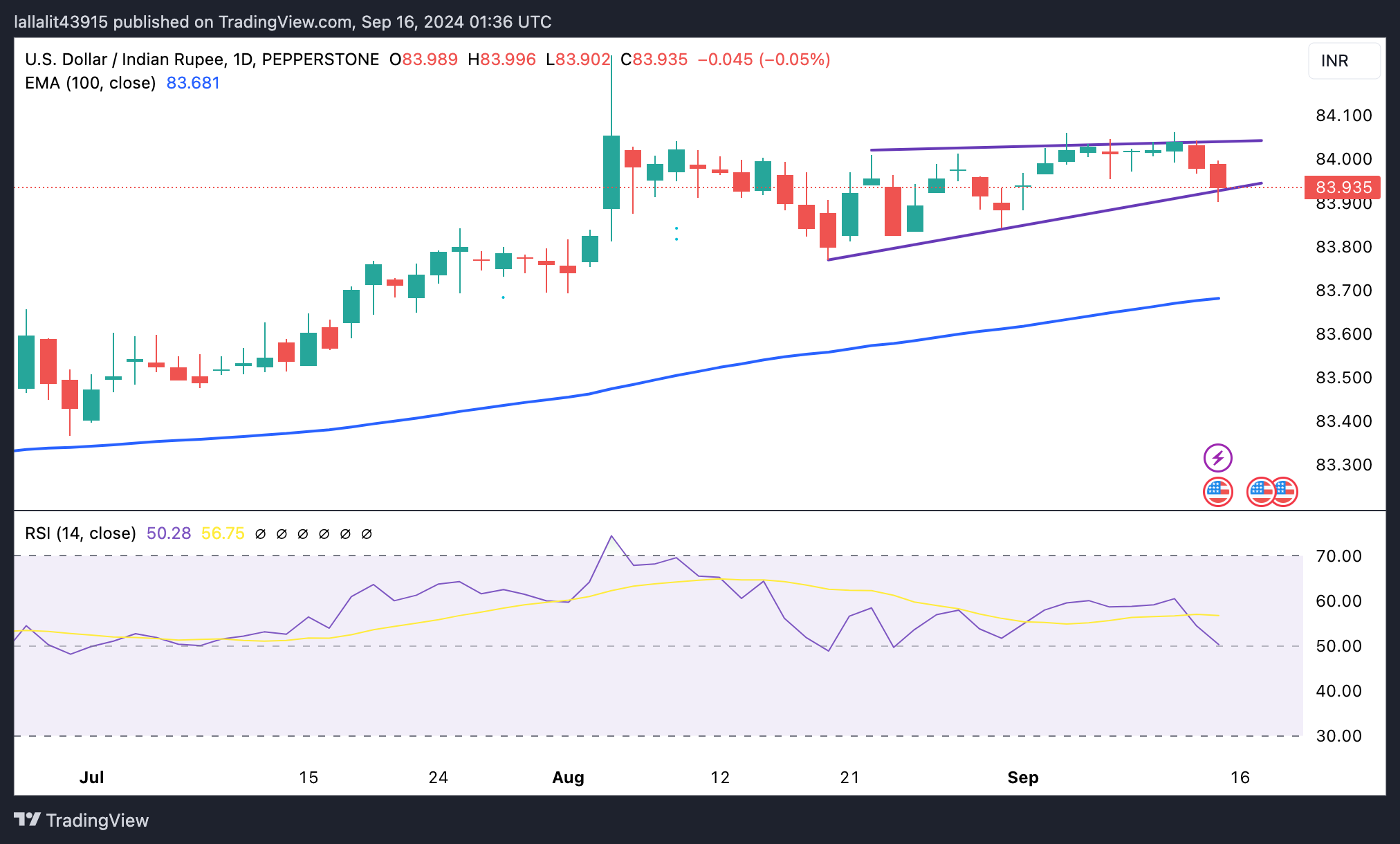USD/INR flat lines despite softer US Dollar, traders await Fed rate decision
- Indian Rupee trades on a flat note in Monday’s Asian session.
- The combination of lower crude oil prices, strong foreign inflows and firmer Fed rate bets underpin the INR.
- Investors await the Indian Trade Balance and US NY Empire State Manufacturing Index, which are due on Monday.
The Indian Rupee (INR) holds steady on Monday despite a weaker US Dollar (USD). The decline in crude oil prices, strong foreign institutional inflows (FII) into the Indian stock market and the odds of an outsized Federal Reserve (Fed) rate cut at its upcoming monetary policy meeting on Wednesday might support the INR.
However, the consistent USD buying by importers and risk aversion ahead of the key event could boost the Greenback. Looking ahead, the Indian Trade Balance and US NY Empire State Manufacturing Index are due on Monday. The Indian Wholesale Price Index (WPI) Inflation and US Retail Sales for August will be released on Tuesday. The US Federal Reserve (Fed) interest rate decision will be the highlight on Wednesday.
Daily Digest Market Movers: Indian Rupee remains flat despite softer USD, lower crude oil prices
- On Friday, the BSE Sensex closed lower by 72 points, down 0.1%, while the NSE Nifty stood lower by 32 points, down 0.1%. Bajaj Finserv, Axis Bank and Wipro were among the top gainers.
- “The US dollar index has fallen from a level of 106 to around 101 in the past three months. Simultaneously, Asian currencies have appreciated against the greenback. The likely interest rate cuts by the US Fed, a sharp drop in crude oil prices and consistent foreign institutional inflows into Indian stock markets are supportive factors for the rupee. However, the local currency has not appreciated; rather, it remains weak against the US dollar,” said Amit Pabari, MD, CR Forex Advisors.
- The Reserve Bank of India Governor Shaktikanta Das said the country’s expected growth rate over the next few years stood at 7.5%, with upside possibilities.
- University of Michigan Consumer Sentiment Index climbed to 69.0 in September from 67.9 in August, better than the estimation of 68.0.
- The markets are now pricing in a 48% possibility of a 25 basis points (bps ) US rate cut on September 17-18, while the chance of a 50 bps cut stands at 52%, according to the CME FedWatch tool.
Technical Analysis: USD/INR’s constructive outlook remains in place
The Indian Rupee trades flat on the day. The USD/INR pair has broken below an ascending triangle on the daily chart. Nonetheless, in the long term, the pair keeps the bullish vibe as it remains above the key 100-day Exponential Moving Average (EMA). Further consolidation cannot be ruled out as the 14-day Relative Strength Index (RSI) hovers around the midline, indicating the neutral momentum of the pair.
Sustained upside pressure past the 84.00-84.05 region, the confluence of the psychological figure, the upper boundary of the triangle and the high of September 11 could take USD/INR up to the next upside barriers at 84.50.
On the flip side, the initial support level emerges at 83.84, the low of August 30. A break below this level could pave the way to the 100-day EMA at 83.68.
Indian Rupee FAQs
The Indian Rupee (INR) is one of the most sensitive currencies to external factors. The price of Crude Oil (the country is highly dependent on imported Oil), the value of the US Dollar – most trade is conducted in USD – and the level of foreign investment, are all influential. Direct intervention by the Reserve Bank of India (RBI) in FX markets to keep the exchange rate stable, as well as the level of interest rates set by the RBI, are further major influencing factors on the Rupee.
The Reserve Bank of India (RBI) actively intervenes in forex markets to maintain a stable exchange rate, to help facilitate trade. In addition, the RBI tries to maintain the inflation rate at its 4% target by adjusting interest rates. Higher interest rates usually strengthen the Rupee. This is due to the role of the ‘carry trade’ in which investors borrow in countries with lower interest rates so as to place their money in countries’ offering relatively higher interest rates and profit from the difference.
Macroeconomic factors that influence the value of the Rupee include inflation, interest rates, the economic growth rate (GDP), the balance of trade, and inflows from foreign investment. A higher growth rate can lead to more overseas investment, pushing up demand for the Rupee. A less negative balance of trade will eventually lead to a stronger Rupee. Higher interest rates, especially real rates (interest rates less inflation) are also positive for the Rupee. A risk-on environment can lead to greater inflows of Foreign Direct and Indirect Investment (FDI and FII), which also benefit the Rupee.
Higher inflation, particularly, if it is comparatively higher than India’s peers, is generally negative for the currency as it reflects devaluation through oversupply. Inflation also increases the cost of exports, leading to more Rupees being sold to purchase foreign imports, which is Rupee-negative. At the same time, higher inflation usually leads to the Reserve Bank of India (RBI) raising interest rates and this can be positive for the Rupee, due to increased demand from international investors. The opposite effect is true of lower inflation.

